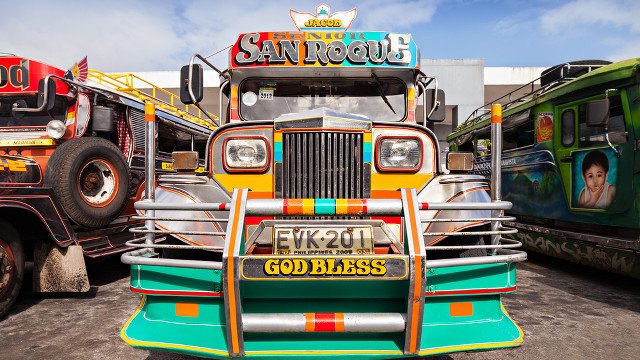One of the main options for getting around Manila, Philippines is hopping in the back of a jeepney – a small bus-like Jeep that has become a national symbol of transportation. These vehicles are about to undergo a major shift in how they are fueled thanks to the COMET (City Optimized Managed Electric Transport), a fully electric-powered city shuttle similar to the jeepney. As President Obama recently experienced first-hand, replacing jeepneys with COMETs is a fantastic way to reduce the fuel and emissions associated with this transit option and one innovative way that the Philippines is reducing their oil use.

A Jeep-what?
The first jeepneys were actually made from U.S. military jeeps left behind after WWII. The discarded jeeps ended up being remodeled to accommodate more passengers and some became bedazzled with colorful ornaments and painted bright colors.
Over the next several decades, the jeepney emerged as a popular and inexpensive means of public transportation and a symbol of Filipino culture. Jeepneys now make up an estimated 40 percent of public utility vehicles in the Philippines and travel along fixed routes between cities and towns, periodically picking passengers up either at designated stops, or wherever along the way. Check out this video below that details an average day in the life of a jeepney driver.
Jeepney Problems
These vehicles, while iconic and ubiquitous, are not the most efficient. As you can probably tell from the video, these vehicles are heavy (Jeepneys weigh about 6,000 lbs and a Cadillac Escalade weighs about 7,000 lbs) and are powered by old diesel engines that maximize torque over efficiency. As a result, they are a major contributor to the climate and air quality concerns that plague the Philippines and especially Manila. The capitol region holds more than 20 million people and frequently faces concentrations of air pollutants that are five times higher than the World Health Organization Air Quality Guidelines.

COMET to the Rescue
So, enter the COMET, a fully electric passenger vehicle that is propelled by an electric motor connected to lithium ion phosphate batteries that have a range of 80 to 100 kilometers per charge. The joint business venture behind the COMET is set to roll the first 30 units out onto Manila streets this summer. The venture is seeking to deploy closer to a thousand by the end of the year and are targeting 15,000 COMETs on Metro Manila streets in the next three to five years.
Aside from the obvious climate and air pollution benefits, these vehicles will also save drivers money. A COMET driver is estimated to spend nearly half as much on fuel when driving on electricity compared to diesel fuel. Filipinos are excited about this development, and so too was President Obama, who stopped by to hop on a COMET during his recent trip through Asia.
I’m also excited to see the COMET take off in Manila, and serve as a model for electrifying other oil-powered transit options in similar cities. So next time you find yourself in the Philippines be on the lookout for a COMET – though I expect they won’t be too hard to find.
This article was originally published on the Union of Concerned Scientists blog, The Equation










